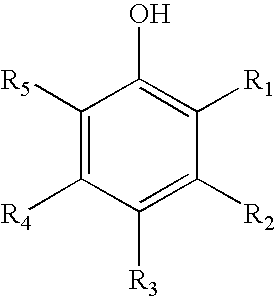Antimicrobial wash formulations including amidoamine-based cationic surfactants
a technology of cationic surfactants and antimicrobial wash formulations, which is applied in detergent compositions, detergent compounding agents, make-up, etc., can solve the problems of increasing the cost of active ingredients used in conjunction with surfactants, and increasing the cost of active ingredients. , to achieve the effect of reducing skin irritation and low use levels
- Summary
- Abstract
- Description
- Claims
- Application Information
AI Technical Summary
Benefits of technology
Problems solved by technology
Method used
Image
Examples
example 1
[0029]The following example shows various amidoamines and their antimicrobial performance when combined with triclosan. The samples were made using IRASAN 300DP, a commercially available tricolsan from Ciba Specalities (United States of America), Mackine™, and various amidoamines from McIntyre Group Ltd. (United States of America), and Purac Hi-Pure USP 90%, a lactic acid from Purac (United States of America).
[0030]First, the amidoamine and the lactic acid were mixed and allowed to react. Enough lactic acid was added to bring the solution to a pH of 5.25. While mixing, the triclosan was added to the solution. After the triclosan was fully dissolved, water was added to make a 100 g batch. The samples were then submitted for microbial time-kill testing. The formulation is generally shown below:
[0031]
ChemicalAmountProcessed Waterq.s. to 100gAmidoamine2.1gTriclosan0.3gCiba Specalities (Irgasan DP300)Lactic Acidq.s. to pH 5.25Purac (Purac HiPure USP 90%)
This formulation was followed for ...
example 2
[0038]This example shows tests of formulations in accordance with Example 1, but with active ingredients other than triclosan, replacing the triclosan ingredient in the amount as shown below.
[0039]
Log Reduction:ChemicalAmountE. coliStaph. aureus (#12228)PCMX0.25 g>5.9>5.7CHG (20:80 chg:water)20.03 g >5.9>5.7Benzethonium Chloride0.10 g>5.90.01Benzalkonium Chloride0.02 g>5.90.01Povidone-Iodine11.03 g >5.9>5.7(10:90 PI:water)
Lauramidopropyl dimethylamine lactate was the amidoamine employed. The results show that this amidoamine is able to work with many different chemical classes, from cationic compounds to phenolic compounds to iodine. The active ingredients tested included parachlorometaxylenol (PCMX), chlorohexidene gluconate (CHG), benzethonium chloride, benzalkonium-chloride, and povidone-iodine.
The two samples containing the quaternary ammonium active ingredients had very poor log reduction values for the Stapholococcus aureus (#12228), but this was expected because other prior f...
example 3
[0040]In the following example various acids were employed to neutralize lauramidopropyl dimethylamine (McIntyre Group Ltd. Mackine™ 801), and the log reduction of the resulting hand wash formulation was determined, as shown in Table 2. Multiple classes of acids were used in combination with the amidoamine to produce a solution at a pH of 5.25+ / −0.50. In this example, the triclosan (Ciba Specalities Irgasan 300DP) was mixed with propylene glycol (Dow Chemical Company: Propylene Glycol USP) until all of the triclosan was dissolved. The lauramidopropyl dimethlyamine was added to the water and then the solution was adjusted with the desired acid to pH 5.25+ / −0.5. Once the pH was adjusted, the propylene glycol / triclosan premix was added to the water solution.
[0041]Although this approach was not used in the prior examples, it allowed for quick batching through faster triclosan solubilization. The cationic surfactant dissolves the triclosan, not the non-ionic form of the compound, and as ...
PUM
| Property | Measurement | Unit |
|---|---|---|
| wt % | aaaaa | aaaaa |
| wt % | aaaaa | aaaaa |
| wt % | aaaaa | aaaaa |
Abstract
Description
Claims
Application Information
 Login to View More
Login to View More - R&D
- Intellectual Property
- Life Sciences
- Materials
- Tech Scout
- Unparalleled Data Quality
- Higher Quality Content
- 60% Fewer Hallucinations
Browse by: Latest US Patents, China's latest patents, Technical Efficacy Thesaurus, Application Domain, Technology Topic, Popular Technical Reports.
© 2025 PatSnap. All rights reserved.Legal|Privacy policy|Modern Slavery Act Transparency Statement|Sitemap|About US| Contact US: help@patsnap.com



